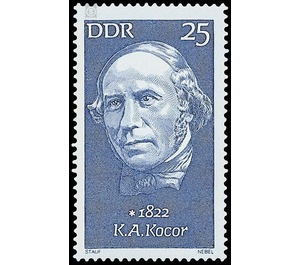Commemorative stamp series - Germany / German Democratic Republic 1972 - 25 Pfennig
Theme: Art & Culture
| Country | Germany / German Democratic Republic |
| Issue Date | 1972 |
| Face Value | 25.00 |
| Color | blue |
| Perforation | K 14 |
| Printing Type | Typography |
| Stamp Type | Postage stamp |
| Item Type | Stamp |
| Chronological Issue Number | 1475 |
| Chronological Chapter | GER-DDR |
| SID | 399137 |
| In 17 Wishlists | |
Important Personalities, Edition 1972 The Ministry of Posts and Telecommunications of the German Democratic Republic publishes five special postage stamps with illustrations of important personalities. No special first-day cover envelope 25-pfennig value Korla Awgust Kocor K. A. Kocor We are one of the most important personalities of Sorbian cultural history in the 19th century. His name is inseparably and indelibly linked to the national awakening of the Sorbian people and the blossoming of his intellectual and cultural life in the pre-March period and the bourgeois revolution of 1848. As the founder of Sorbian art music, he initiated the first significant period of Sorbian music history with his compositional oeuvre. Kocor was born on December 3, 1822 in Berge near Großpostwitz, Kreis Bautzen, the son of a wheelwright. He attended the Bautzen Landstädtische Lehrerseminar and received at this institution a solid music education. Since 1842 Kocor lived and worked as a vicar and teacher in Wartha near Guttau in the district of Bautzen. In 1844 he met with the well-known Sorbian folk poet Handrij Zejler (1804-1872) together. This meeting was the beginning of a fruitful artistic creative alliance and a long-standing friendly relationship between the poet and the composer. In 1852 he moved to Kittlitz near Löbau. where he was from then on as a first teacher and cantor and also died there on May 19, 1904. Kocor's folk-song melodies were the focus of the Sorbian song festivals, which had become a tradition since 1845, and conquered the hearts of the Sorbian people on the fly. His first successful compositions were the polonaise "Sorbian May" and the song "To the beautiful Lusatia" (1845), which became the hymn of the Sorbian people. In 1847 his first oratorio "The Sorbian Wedding" was performed. The five-part oratorio cycle "The Seasons" with the vocal works "The Harvest" (1849), "The Spring" (1860), "The Early Summer" (1883), "The Autumn" (1886) and "The Winter" (1887) to the most important sound creation Kocors. Of these works, the oratorio "Spring" is a culmination of all his artistic work. His larger compositions also include the two oratorios "Israel's mourning and consolation" (1861) and "Friedensgeläute" (1891). In the years 1850-1871 Kocor created the first Sorbian opera Jakob and Kata ", to which he wrote the Overture in 1848. Numerous song compositions and arrangements as well as chamber music works complete the picture of his work and his compositions still occupy an important place in the musical life of the Sorbian people and enjoy the widest popularity.


